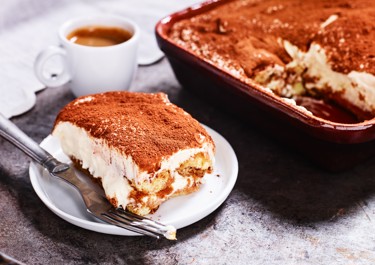
Tiramisù

Instructions
Tiramisù
Ingredients
|
Strong coffee
|
200 ml |
|---|---|
|
Liqueur, e.g. amaretto
|
3 tbsp |
|
Savoiardi biscuits
|
200 g |
|
Egg whites
|
4 |
|
Egg yolks
|
2 |
|
Powdered sugar
|
90 g |
|
Double cream
|
250 ml |
|
Cream cheese, natural
|
450 g |
To garnish
|
Cocoa powder
|
2 tbsp |
|---|
Tiramisù: the quintessential Italian dessert
This beloved Italian dessert is rich and elegant, yet simple to make. With good-quality ingredients and some planning ahead, you can serve a show-stopping tiramisù at your next dinner party.
The origins of tiramisù
Tiramisù is Italian for ‘cheer me up’ and there can be no doubt that Italy is its birthplace. But with a dessert as beloved as this, there is bound to be competing origin stories and even legends detailing its invention. Several Italian towns and regions have claimed to be the true home of tiramisù. Today, however, most chroniclers agree that the dessert was first served under this name in the 1960s at Le Beccherie, a restaurant in the northern Italian city of Treviso. Tiramisù then spread and grew in popularity, becoming a global restaurant phenomenon in the 1980s.
How to vary your tiramisù
The idea behind tiramisù – an indulgent dessert made of layers of different flavours and textures – can be tweaked and reinterpreted to match the season, the context, or your personal taste. You can even make strawberry or raspberry tiramisù, with biscuits soaked in a mixture of fruit preserve and liqueur. For a citrusy variation on the same theme, you can use juice, zest, and curd of lemon in the different layers. Or go for a truly family-friendly version by leaving out the coffee and alcohol and simply incorporating as much chocolate as you can in each layer.
The layers of tiramisù
The classic way to layer a tiramisù is to start with the ladyfingers or savoiardi, briefly soaked in coffee and marsala wine or liqueur. Next comes half of the egg, cream, and cheese mixture. Then another layer of soaked biscuits followed by a final layer of the creamy mixture. This is topped with a good layer of grated dark chocolate or cocoa powder for the final irresistible touch. The resulting tiramisù should have distinct and visible layers to admire as you serve it.
How to serve tiramisù
You can make tiramisù in a large dish, preferably square or rectangular, and then serve pieces of the dessert on plates or in dessert cups. Another method is to make it in individual glass cups that show off the layers in the dessert. For this you may need to break the biscuits into smaller bits. But don’t make the bits too small, as this increases the risk of a soggy dessert.







